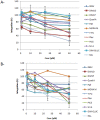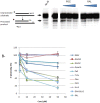Natural stilbenoids isolated from grapevine exhibiting inhibitory effects against HIV-1 integrase and eukaryote MOS1 transposase in vitro activities
- PMID: 24312275
- PMCID: PMC3842960
- DOI: 10.1371/journal.pone.0081184
Natural stilbenoids isolated from grapevine exhibiting inhibitory effects against HIV-1 integrase and eukaryote MOS1 transposase in vitro activities
Abstract
Polynucleotidyl transferases are enzymes involved in several DNA mobility mechanisms in prokaryotes and eukaryotes. Some of them such as retroviral integrases are crucial for pathogenous processes and are therefore good candidates for therapeutic approaches. To identify new therapeutic compounds and new tools for investigating the common functional features of these proteins, we addressed the inhibition properties of natural stilbenoids deriving from resveratrol on two models: the HIV-1 integrase and the eukaryote MOS-1 transposase. Two resveratrol dimers, leachianol F and G, were isolated for the first time in Vitis along with fourteen known stilbenoids: E-resveratrol, E-piceid, E-pterostilbene, E-piceatannol, (+)-E-ε-viniferin, E-ε-viniferinglucoside, E-scirpusin A, quadragularin A, ampelopsin A, pallidol, E-miyabenol C, E-vitisin B, hopeaphenol, and isohopeaphenol and were purified from stalks of Vitis vinifera (Vitaceae), and moracin M from stem bark of Milliciaexelsa (Moraceae). These compounds were tested in in vitro and in vivo assays reproducing the activity of both enzymes. Several molecules presented significant inhibition on both systems. Some of the molecules were found to be active against both proteins while others were specific for one of the two models. Comparison of the differential effects of the molecules suggested that the compounds could target specific intermediate nucleocomplexes of the reactions. Additionally E-pterostilbene was found active on the early lentiviral replication steps in lentiviruses transduced cells. Consequently, in addition to representing new original lead compounds for further modelling of new active agents against HIV-1 integrase, these molecules could be good tools for identifying such reaction intermediates in DNA mobility processes.
Conflict of interest statement
Figures








References
-
- Engelman A, Mizuuchi K, Craigie R (1991) HIV-1 DNA Integration: Mechanism of viral DNA Cleavage and strand transfer. Cell 67: 1211–1221. - PubMed
-
- Carpentier G, Jaillet J, Pflieger A, Adet J, Renault S, et al. (2011) Transposase-transposase interactions in MOS1 complexes: a biochemical approach. J Mol Biol 405: 892–908. - PubMed
Publication types
MeSH terms
Substances
LinkOut - more resources
Full Text Sources
Other Literature Sources

